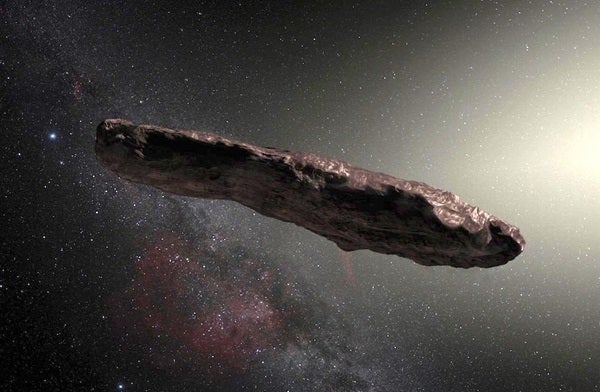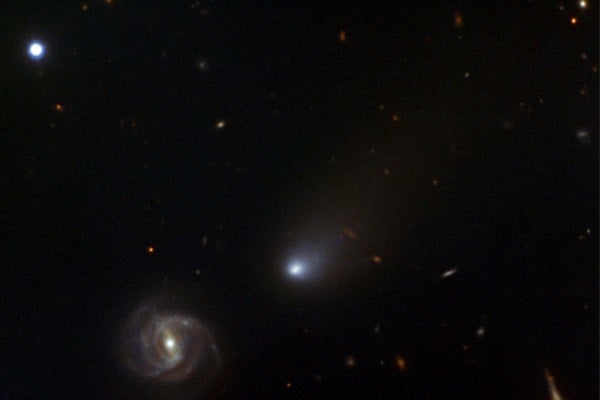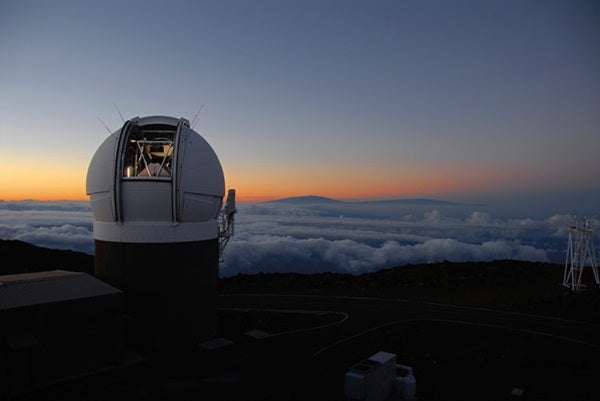One of the weirdest objects ever discovered in our solar system — the alien space rock ‘Oumuamua — is still sparking debates more than two years after its discovery. And, most recently, the conversation has shifted to whether the cosmic visitor could be a fragment ripped from a larger world.
In 2017, the Pan-STARRS asteroid-hunting telescope in Hawaii spotted an object moving at a breathtaking pace of 54 miles (87 kilometers) per second. But, unlike most comets and asteroids before it, ‘Oumuamua would only approach our Sun once before continuing its journey through space. This made it the first known interstellar object to have passed through our solar system.
Scientists named the alien space rock ‘Oumuamua, which roughly translates as “messenger from afar arriving first” in Hawaiian. And though astronomers agree that ‘Oumuamua visited our solar system from another star, that’s about where the agreement ends.
Is it an alien asteroid, an alien comet, or even an alien spaceship?
Now, a pair of astronomers have used complex computer modeling to explain ‘Oumuamua’s combination of strange properties, finding the space rock may be a small shard ripped from a larger parent body.
Their models suggest that when an object — anything from a comet to a super-Earth — passes too close to its star, intense tidal forces can cause heated fragments to slough off. These melted shards then refreeze, locking in their unique shapes.
If these astronomers are right, then we should expect to spot plenty of oddly shaped worlds like ‘Oumuamua in the coming years.
“We anticipate many more interstellar visitors with similar traits to ‘Oumuamua will be discovered by future observation,” says study author Yun Zhang from the National Astronomical Observatories of the Chinese Academy of Sciences.
The new findings were published Monday in the journal Nature Astronomy.
‘Oumuamua: Asteroid or comet?
Astronomers expected the first interstellar object they’d discover would be an alien comet. This is because comets orbit in the outskirts of star systems, and stars pass relatively near each other somewhat frequently. So, when two stars fly by each other, the gravitational interaction can rip comets from their loosely tethered orbits, flinging them out into space.
This ejection mechanism was further supported last year when astronomers discovered the interstellar comet 2I/Borisov, which looks reassuringly like the “dirty snowballs” found in our own solar system. It also exhibited a conventional cometary tail — the extended, fuzzy line of sublimated gas and ice that streams from comets as they approach the Sun.
But ‘Oumuamua left astronomers with more confusing hints about its nature and history. Instead of growing an icy tail, this alien space rock looked relatively dry. It also appeared surprisingly dense and rocky.
Its shape was even more perplexing. Most space rocks in our solar system are shaped something like a potato — or, in the case of Arrokoth, like two of them smashed together. But ‘Oumuamua is long and stretched out, more like a cigar.

Asteroids offer clues to the early solar system and the promise of precious resources. That is, assuming they don’t kill us first. To learn more, download our free eBook: Defending Earth from Asteroids.
Sand castles among the stars
Zhang and study co-author Douglas Lin from the University of California, Santa Cruz, set out to explain ‘Oumuamua’s weird properties. They simulated what would happen as an object flew extremely close to its home star. Their models showed that the tidal forces could literally shred it into long fragments before chucking them out into space.
The authors say that you can imagine planetary bodies as sand castles floating in space. Much like children on the beach molding castles from many grains of sand, even modest worlds are built from many smaller pieces that are held together by gravity.
And when an outside force acting on a planetary grain grows stronger than the gravity binding it to the parent body, that smaller piece is yanked from the whole. This is what happens when an object ventures too close to a star. Astronomers previously saw the process unfold when comet Shoemaker-Levy 9 was ripped apart by Jupiter.
“The near and far parts of the planetary body are pulled apart from each other by the star’s tidal forces, forming an elongated band of ‘sand particles,’” Zhang says, extending the analogy. “At the same time, since the body is so close to the star, some of its surface melts and freezes after it flies away. This process glues the surface ‘sand particles’ together, and helps to form elongated fragments.”
And according to the research, ‘Oumuamua could very well be one such elongated fragment.
The researchers aren’t the first to propose an idea like this, however. Previous modeling work published by astronomer Sean Raymond of Laboratoire d’Astrophysique de Bordeaux in Bordeaux, France, had already used computer models to show that ‘Oumuamua could be a shredded chunk of planetesimal created during the formation of a fledgling planetary system.
But not everyone is convinced by the argument.
The debate continues
Karen Meech, an astronomer at the University of Hawai‘i who has studied ‘Oumuamua but wasn’t involved in this research, says she still believes the space rock has to be a comet. Part of why she thinks that is because one piece of evidence hinting that the space rock is an asteroid could simply be a dearth of observations.
She points out that ‘Oumuamua’s high-speed trip through the solar system was too quick for astronomers to get a detailed look at the object.
“Most of the observations of ‘Oumuamua had to occur within a one-week period, and we simply did not have the ability to detect water,” she says. “That isn’t a lack of water. We just didn’t have the sensitivity to see it.”
And there’s another outstanding property these researchers haven’t explained yet, she says. ‘Oumuamua’s movement through our solar system implied it was being driven by more than just gravity — like a comet whose direction is slightly changed by the force of gases streaming off of it.
“I think it absolutely is a comet,” Meech says. “The nongravitational motion that our group detected was super strong, and there’s no other way to maintain it except for outgassing. There’s no other explanation.”
Because of ‘Oumuamua’s incredible speed, even the fastest spaceship humanity has ever built, NASA’s Parker Solar Probe, couldn’t catch it. As quickly as it came, the alien interloper was gone, never to be seen again.
“We will never know for sure where ‘Oumuamua came from or where it was created, and I’ve been very impressed with the models and the way people have tried to explain it,” Meech says. “I don’t think it proves anything.”
However, future observations still could help resolve the argument. If Zhang and Lin are right, interstellar asteroids may be even more common than interstellar comets, the authors say. These alien asteroids would be relatively small and lack the comas of comets, which would make them much harder to detect while they’re passing through our solar system. However, new cutting-edge telescopes, like the Vera C. Rubin Observatory being built in Chile, could spot them.
“‘Oumuamua is just the tip of the iceberg,” Lin said in a media release. “We anticipate many more interstellar visitors with similar traits will be discovered by future observation.”












